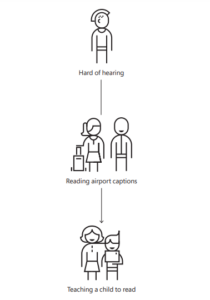Inclusive design is integral to being a designer. We need to be able to reach as many people as possible. Today, with different software and technology, we have different ways of including those who have any sort of impairment, so they’ll be able to interact with the content.
Points of Exclusion: Video and Audio
The primary deliverable of my project that I am creating is video content. Along with it, as it is with most video, comes the audio aspect as well. Having just the video and audio means that it excludes those with any sort of visual and hearing impairment. Without inclusion features and solutions those with these impairments, whether it’s a permanent impairment like being blind or just a temporary impairment like being in an overly loud place, would not be able access these videos as well as they could.
Design Solutions
To make sure my content that I make is as inclusive as possible, I can come up with potential solutions that will prevent the exclusion of people that may issues with their sight or hearing. Focusing on video first, there are several ways to make sure those with visual impairment are included fully with the content. A potential solution to this an audio descriptions for video. These descriptions are for video and directly narrate what is being shown on screen for those who may not be able to either see the screen well or can not be in front of the screen at all times. Many videos do not use this feature though there are ways to record and add these descriptions through software. There are many ways this can be used to include all sorts of people, not just those who are permanently blind.
In terms of my other deliverable, the audio side of things, I need to make sure that people who are hard of hearing or otherwise hearing-impaired, can access and interact with my media. An obvious solution to this is to include closed captions on all my videos. Closed captions make sure that anything that someone would be able to hear, which includes words and background music, are articulated on the screen. This way, those affected by hearing loss can follow what is being portrayed in the video, even though they can’t necessarily hear what’s happening. Another way this can be addressed is through transcripts. Transcripts can help those who struggle with hearing but may not be able to access closed captions for whatever reason and want to know what a video is about. It’s a different and accessible way for video and audio content to be consumed.
It needs to be understood that there are many affected by lack of sight or hearing. This is covered in Microsoft’s Inclusive Design Toolkit which covers this idea of “Solve for One, extend to many”. It shows that it may be specifically for one issue, yet it helps many who might be in different situations. As I design and create my project, this idea helps me stop and find solutions, such as the audio descriptions, to be inclusive to as many people as possible.

An example”Solve for one, extend to many”, included in the toolkit
Project Distribution
I would like my videos to get attention primarily within the Saint Joseph’s University community of students. I will obviously be focusing on organizations within SJU and want to be able to reach them about what it has to offer in terms of the performing arts. To do this, I think I’ll look to the organizations themselves and the people in them. They can post about on the organization social media accounts as well as any individual accounts they use. This way, we’ll get a reach on not only the people that are involved, but also those that are within the Saint Joseph’s community and not involved. Ideally, I will be using my design solutions that were discussed above to make sure that everyone is welcome. The whole point of my project is to show that there is not just one type of person that can do performing arts. This is why inclusivity in my project is so important.

Stage Flight is a performing arts organization on SJU’s campus.They can use their Instagram to promote the videos being released
Leave a Reply